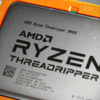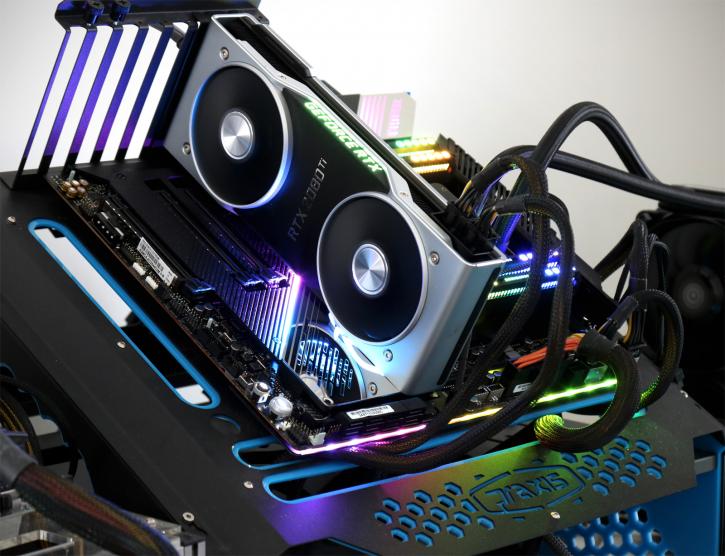Conclusion
Final Words
Describing what AMD is bringing to the table is a conundrum, there are so many superlatives that come to mind that I do not even know where to begin. Each and every time we receive a new Threadripper, and we reviewed them all ever since gen1, they just keep getting better and better. I mean I popped in the 3990X, turned on the PC, loaded up the XMP 3600 MHz profile and booted into Windows, literally since day one of testing this system it has not had any issues or hiccups. Considering I inserted probably the most spectacular processor (from a design point of view) of the year 2020 in this system, that alone is a staggering fact. It just works. Honestly, I expected problems... applications not starting, weird TDP things, but nothing -- this 64-core processor uses exactly the same amount of power as the 32-core version. Obviously, the compromise is a lower base frequency, but once those 64 little critters kick in, the teamwork they bring into play crushes anything and everything. Granted, your applications need to be mega-threading capable. As you have seen throughout our benchmark suite, some titles are still stuck at 16 threads maximum. This is and was expected. But here as well, many applications did actually kick in, and the results are more than enough to make a substantial difference. Yes, 8x 8-core dies and an IO chip will create issues of their own in terms of efficiency, scaling and latency, but AMD was able to manage it, and keep potential inefficiency effects to a minimum. And I am now more clearly understanding why AMD went so hard by pushing PCIe Gen 4.0, as the internal lanes are so fast that you can stitch those 8x 8-core dies and that IO chip together and still offer a processor that is horrendously capable. Never, ever has any consumer been able to purchase a 12, 16, 24, 32 and now 64-core processor in this price range as that was exclusive to a very expensive server market dominated by Intel. I'll say it again, this is a processor available in the consumer market but obviously intended for those that need to perform content creation, virtualization, animation, video editing, modeling, and raytraced rendering. It is so impressive and diverse as to what AMD brings to the table that I need to break down this conclusion page into several chapters.
Performance
If the software application supports 64/128 threads, there's nothing stopping this processor ripping threads and spitting out serious numbers that will make your eyebrows frown, and then some. As mentioned, there are eight 8-core dies on the package with an IO chip, they're now referred to as chiplets. A product so complex will bring some latency and scaling issues into play. Going from 32 to 64 cores is not going to double the performance if the software can deal with it, however, things will scale upwards quite a notch. The thing is, things like latency have been addressed by the huge on-die caches and fast PCIe 4.0 interconnecting interfaces. However, AMD wanted to really stick by the 280 Watt TDP. Listen closely, the 24, 32 and 64 core parts all have that same TDP. That is remarkable, as the 32-core part has four CPU dies, the 64-core part has eight of them. So, scaling is not 100% as the base-clock was brought down. That base-clock is the conundrum of scaling. So if all cores are stressed, the 32-core 3970X would have them at 3.7 GHz, while the 64-core 3990X is at 2.9 GHz. 800 Mhz difference might not sound like an extreme amount, however, that is 64x 800 Mhz difference. And that is your answer to any scaling questions you might have. Are fewer threads active? That's when the up-to 4.3 GHz Turbo will kick in again. It's a beautiful thing to observe really. Never ever has my testing been this fast, I mean we had to update several titles in the software suite to be able to pass 32 threads, but you've seen the numbers for Cinebench 20, Vray NEXT and MAYA, there's just nothing that competes on a single socket, not even in the server market.
TRX40 and PCIe Gen4 all the way
TRX40 holds ground, you slide in the 64-core part and it just works. The chipset is overloaded with features, and everything with PCIe Gen 4.0, including that quadruple interconnect in-between the chipset and CPU. With that PCIe 4.0 x8 interlink, that is just unheard of and unprecedented even in the server segment. A Threadripper 3000 processor brings 64 PCIe Gen 4 lanes to the table, 8 of those have been reserved for the chipset link and then the chipset link brings in a further 24 PCIe Gen 4 links to the table with 8 reserved for that interconnect. That's 88 PCIe Gen 4 lanes in total and thus 72 lanes available to the end-user.
Stability
Actually, I already mentioned that in the first paragraph, but we popped in the 64-core processor, loaded the BIOS and activated XMP and we've been good to go ever since. Not a single hiccup or crash, the platform is dauntingly stable. There's little more I could say or write here really.
Gaming
Yeah, gaming... I was not expecting much of it. I mean if you spend 3990 USD on a 64-core processor to play games, then you're pretty much a fool. However, we need to reverse that; if you have complex workloads and would like to be able to play a game every now and then as well, well you've seen the numbers. Anything starting at Full HD is totally fine. In the words of somebody famous, yes you can. Obviously there will be games out there that will not work with 48, 64, 128-threads fired off at them, we had one (Far Cry 5 performed quite badly and as such was left out), the rest was really okay though and up-to 'normal' Ryzen level performance. But sure, there will likely be some scenarios where the game has got no clue what it is looking at. Luckily you can always grab AMD's Ryzen Master software, allowing you to switch to a game mode and have limited cores enabled allowing you to open up compatibility with all and any game(s). The performance itself is good, but surely not the reason why you would buy such a many-core processor. But then again... very, very, very decent framerates.
The Memory
Threadripper fully supports most memory even starting at 3200, 3466, 3600 MHz and upwards. We do recommend you to stick to 3600 MHz as maximum with some tight timings. Keep in mind, you now have quad-channel memory available, doubling up memory bandwidth. So in the long run, memory-wise you'll benefit a bit more from lower latency memory as opposed to faster frequency memory. For those that virtualize a lot and run databases, there is ECC memory compatibility as well. Overall, 3200 MHz CL14 or 3600 MHz CL16 would be my recommendation. We tested with both the Zenith II Extreme and new Alpha revision (has improvements to go even faster on the memory subsystem). We used a 64 GB Corsair kit at 3600 MHz CL16, after enabling the XMP we were ready to go and all set up. So, memory compatibility and stability were truly good. If you are considering a platform like this, please do check the QVL list of the motherboard manufacturer for proper compatible memory DIMMs.
The Tweak
You can tweak the processor, but you will also understand the complication of running 64 cores in an all-core overclocked mode. That will generate heat and tremendous power consumption. Surely you are not willing to mess up that 3990 USD processor that already runs so very fast. Yes, we're not going to recommend any overclocking. But if you want to, it'll take patience, good cooling, a lot of effort and a really capable power supply.
The conclusion
Waking up in the morning and walking by that 128-threaded beast continuously makes me want to softly whisper some dirty talk to it as, man, that thing is sexy. I stated already in the first paragraph that I am short of superlatives for this product. We do have one last thing remaining to discuss though, who this product is for. It is released in the consumer and SOHO domain and, yes, the market will be small. Regardless, AMD released the 64-core part, maybe a little to flip Intel the finger, but there actually is an install/user base for this product. Encoding video or rendering 3D on 64 cores is just insane. Rendering workloads that normally take 24 hours could end up taking three hours. So the productivity of the ecosystem and your workload is easily increased by a factor of 5 to 8 (I do need to account for performance scaling).
If I may throw another example into play, this 64-core processor is a virtualization dream. I mean, install Proxmox on a fast NVMe SSD, and if you have that 256GB memory installed, you can create 16 quad-core VPS servers each with 16GB of memory. Think about that for a second and realize how flexible and nearly crazy that is with a base clock of 2.9 GHz. I mean, for Intel you need a many-core Xeon processor to be able to pull that off, often running 2.1 GHz per core and double to quadruple the cost. That workload also has an amazing TDP, I mean our system power under full load was roughly 400 Watts, divided by 64 cores that is a cost of 7 Watts per core. To compare a little, for the Core i9 9900KS that value is 30 Watts per core and 18 Watts per core for the Core i9 10980. So while that 280 Watt TDP rating would make anyone's eyebrows frown, the reality is way more simple as, relatively speaking, this processor is managing its energy efficiency extremely well. Btw, that 7 Watts again, is based on total system power. I also look at on-chip power consumption, and per-core, we're seeing 2.5 Watts under load. But again, we measure the power needed for the entire platform. Cooling and temperatures then, we've seen all cores stressed bringing a load temperature sitting in the 75 Degrees C domain, which for 64-cores is pretty terrific. We did apply a 280mm LCS kit, but that's more than sufficient. Relative to that, you need to remember, this is a 280W TDP processor, so you simply need a 280W capable cooler.
In the end, Threadripper's biggest processors serve the smallest portion of the market but do have the biggest effect in that same market. For us common folk, Threadripper processors may not even make any sense, I mean you can get one for bragging rights and fun if you wanted to, nobody would hold it against you. The reality is however that procs like shown today are GOLD for the companies and prosumers that need highly threaded PCs for complex and demanding workloads. The Ryzen Threadripper 3990X will sell at 3990 USD which is a tremendous amount of money, sure. But even so, it screams value as never ever have mega-core processors been this cheap, this flexible and this fast. What else can we hand out other than a Guru3D top pick award and bow to AMD.
- Sign up to receive a notification when we publish a new article
- Or go back to Guru3D's front page.



